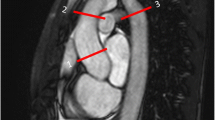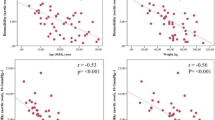Abstract
To evaluate the association between aortic morphology and elasticity with aortic regurgitation in surgically corrected of tetralogy of Fallot (TOF) patients. We retrospectively identified 72 consecutive patients with surgically corrected TOF and 27 healthy controls who underwent cardiac MRI evaluation. Velocity-encoded cine MRI was used to quantify degree of aortic regurgitation (AR) in TOF patients. Ascending aorta diameters were measured at standard levels on MRA images. Aortic pulse-wave velocity (PWV) was quantified with MRI. Morphological and functional MRI variables were compared between groups of TOF patients with and without clinically relevant AR and controls. The association between aortic morphology and elasticity with the presence of AR was evaluated using univariate and multivariate logistic regression. The majority of TOF patients had only trace AR. Nine TOF patients (12 %) had an AR fraction higher than 15 %. Indexed aorta diameter at the sinotubular junction (p = 0.007), at the RPA level (p = 0.006), and low left ventricular ejection fraction (LVEF) (p = 0.015) showed the strongest associations with the presence of at least mild AR, which persisted after controlling for age and gender. Increased ascending aorta dimension is associated with AR in patients after repair of TOF. LVEF was also low in the group of patients with relevant AR compared to those without, suggesting even mild to moderate AR may contribute to LV dysfunction in these patients. Enlarged ascending aorta may be an indication for precise quantification of regurgitant fraction with MRI, since symptomatic patients may need aortic valve repair when moderate regurgitation is present.



Similar content being viewed by others
References
Murphy JG, Gersh BJ, Mair DD et al (1993) Long-term outcome in patients undergoing surgical repair of tetralogy of Fallot. N Engl J Med 329(9):593–599
Nollert G, Fischlein T, Bouterwek S, Bohmer C, Klinner W, Reichart B (1997) Long-term survival in patients with repair of tetralogy of Fallot: 36-year follow-up of 490 survivors of the first year after surgical repair. J Am Coll Cardiol 30(5):1374–1383
Deanfield JE, Ho SY, Anderson RH, McKenna WJ, Allwork SP, Hallidie-Smith KA (1983) Late sudden death after repair of tetralogy of Fallot: a clinicopathologic study. Circulation 67(3):626–631
Niwa K (2005) Aortic root dilatation in tetralogy of Fallot long-term after repair—histology of the aorta in tetralogy of Fallot: evidence of intrinsic aortopathy. Int J Cardiol 103(2):117–119
Niwa K, Perloff JK, Bhuta SM et al (2001) Structural abnormalities of great arterial walls in congenital heart disease: light and electron microscopic analyses. Circulation 103(3):393–400
Tan JL, Davlouros PA, McCarthy KP, Gatzoulis MA, Ho SY (2005) Intrinsic histological abnormalities of aortic root and ascending aorta in tetralogy of Fallot: evidence of causative mechanism for aortic dilatation and aortopathy. Circulation 112(7):961–968
Niwa K, Siu SC, Webb GD, Gatzoulis MA (2002) Progressive aortic root dilatation in adults late after repair of tetralogy of Fallot. Circulation 106(11):1374–1378
Kim WH, Seo JW, Kim SJ, Song J, Lee J, Na CY (2005) Aortic dissection late after repair of tetralogy of Fallot. Int J Cardiol 101(3):515–516
Rathi VK, Doyle M, Williams RB, Yamrozik J, Shannon RP, Biederman RW (2005) Massive aortic aneurysm and dissection in repaired tetralogy of Fallot; diagnosis by cardiovascular magnetic resonance imaging. Int J Cardiol 101(1):169–170
Capelli H, Ross D, Somerville J (1982) Aortic regurgitation in tetrad of Fallot and pulmonary atresia. Am J Cardiol 49(8):1979–1983
Geva T, Sandweiss BM, Gauvreau K, Lock JE, Powell AJ (2004) Factors associated with impaired clinical status in long-term survivors of tetralogy of Fallot repair evaluated by magnetic resonance imaging. J Am Coll Cardiol 43(6):1068–1074
Ishizaka T, Ichikawa H, Sawa Y et al (2004) Prevalence and optimal management strategy for aortic regurgitation in tetralogy of Fallot. Eur J Cardiothorac Surg 26(6):1080–1086
Geva T (2011) Repaired tetralogy of Fallot: the roles of cardiovascular magnetic resonance in evaluating pathophysiology and for pulmonary valve replacement decision support. J Cardiovasc Magn Reson 13:9
Valente AM, Cook S, Festa P et al (2014) Multimodality imaging guidelines for patients with repaired tetralogy of fallot: a report from the American Society of Echocardiography: developed in collaboration with the Society for Cardiovascular Magnetic Resonance and the Society for Pediatric Radiology. J Am Soc Echocardiogr 27(2):111–141
Nishimura RA, Otto CM, Bonow RO et al (2014) AHA/ACC guideline for the management of patients with valvular heart disease: a report of the American College of Cardiology/American Heart Association Task Force on Practice Guidelines. J Thorac Cardiovasc Surg 2014;148(1):e1–e132
Heiberg E, Sjogren J, Ugander M, Carlsson M, Engblom H, Arheden H (2010) Design and validation of Segment—freely available software for cardiovascular image analysis. BMC Med Imaging 10:1
van Elderen SG, Westenberg JJ, Brandts A et al (2011) Increased aortic stiffness measured by MRI in patients with type 1 diabetes mellitus and relationship to renal function. Am J Roentgenol 196(3):697–701
Ibrahim el SH, Johnson KR, Miller AB, Shaffer JM, White RD (2010) Measuring aortic pulse wave velocity using high-field cardiovascular magnetic resonance: comparison of techniques. J Cardiovasc Magn Reson 12(1):26
Grothoff M, Mende M, Graefe D et al (2016) Dimensions of the ascending aorta in children and adolescents with repaired tetralogy of Fallot obtained by cardiac magnetic resonance angiography. Clin Res Cardiol 105(3):239–247
Dearani JA, Burkhart HM, Stulak JM, Sundt TM, Schaff HV (2009) Management of the aortic root in adult patients with conotruncal anomalies.In: Seminars in thoracic cardiovascular Surgery: pediatric cardiac surgery annual, pp 122–129
Rajiah P (2013) CT and MRI in the evaluation of thoracic aortic diseases. Int J Vasc Med 2013:797189
Muzzarelli S, Ordovas KG, Cannavale G, Meadows AK, Higgins CB (2011) Tetralogy of Fallot: impact of the excursion of the interventricular septum on left ventricular systolic function and fibrosis after surgical repair. Radiology 259(2):375–383
Senzaki H, Iwamoto Y, Ishido H et al (2008) Arterial haemodynamics in patients after repair of tetralogy of Fallot: influence on left ventricular after load and aortic dilatation. Heart 94(1):70–74
Grotenhuis HB, Ottenkamp J, de Bruijn L et al (2009) Aortic elasticity and size are associated with aortic regurgitation and left ventricular dysfunction in tetralogy of Fallot after pulmonary valve replacement. Heart 95(23):1931–1936
Funding
No funding was available for this study.
Author information
Authors and Affiliations
Corresponding author
Ethics declarations
Conflict of interest
None of the authors have any conflict of interest to disclose.
Ethical approval
All procedures performed in studies involving human participants were in accordance with the ethical standards of the institutional and/or national research committee and with the 1964 Helsinki declaration and its later amendments or comparable ethical standards.
Informed consent
Informed consent was obtained from all individual participants included in the study.
Rights and permissions
About this article
Cite this article
Ordovas, K.G., Keedy, A., Naeger, D.M. et al. Dilatation of the ascending aorta is associated with presence of aortic regurgitation in patients after repair of tetralogy of Fallot. Int J Cardiovasc Imaging 32, 1265–1272 (2016). https://doi.org/10.1007/s10554-016-0902-4
Received:
Accepted:
Published:
Issue Date:
DOI: https://doi.org/10.1007/s10554-016-0902-4




